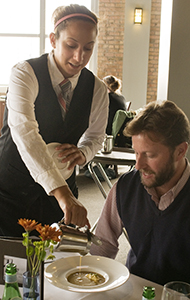Teaching and Implementing the New Interaction Economy, Part I
Tuesday, 17 June 2014 14:09
 Americans are said to live and operate in an “experience” economy. But a new way of creating value via loyalty rather than premium price is beginning to emerge. What does this mean to our students and their future careers in foodservice? Part one of a two-part focus.
Americans are said to live and operate in an “experience” economy. But a new way of creating value via loyalty rather than premium price is beginning to emerge. What does this mean to our students and their future careers in foodservice? Part one of a two-part focus.
By Renee Zonka, RD, CEC, CHE, MBA
For decades through the 1990s, the U.S. economy was chiefly described as a “service” economy. An argument can be made that ours is still a service economy because more than 50% of the labor force in the United States is in the service sector as opposed to agriculture or manufacturing. How often have you called a company for service and spoken to someone with a foreign accent? Of course, I’m speaking of customer service. We’ve exported the delivery of so many services that many developing nations are considered service economies today.
Of course, a service economy can also refer to the relative importance of service in a product offering. Products today have a higher service component than in previous decades, and, virtually every product today has a service component to it. So there’s a strong case to be made that we’re still living and operating within a service economy.
The “Experience” Economy
But identifying our economy began to change in 1999 with the publication of a book by B. Joseph Pine, II, and James H. Gilmore, The Experience Economy: Work Is Theatre & Every Business a Stage. Everyone can identify with the basic premise of an experience economy, in which companies state an “experience” when they engage customers in a memorable way.
Here’s an example: Kendall College operates a white-tablecloth restaurant open to the public that doubles as a real-life classroom for culinary-arts students, called, simply, The Dining Room. Peggy Ryan, a culinary instructor and daytime executive chef of The Dining Room, once menued a lentil soup with peppered crème fraîche and fried celery leaves. The student server placed a bowl in front of the guest that contained only the crème fraîche with the fried celery leaves. So it wasn’t soup when it arrived at the table. It became soup in front of the guest’s eyes when the student poured it into the bowl. For the guest, the act was lagniappe—a little something extra, as they say in New Orleans—that heightened the dining experience.

 The Global Culinary Innovators Association and International Food and Beverage Technology Association announced their respective formations at the industry’s largest trade show last month.
The Global Culinary Innovators Association and International Food and Beverage Technology Association announced their respective formations at the industry’s largest trade show last month. Research and trend predictions point in the same direction: Use more fresh mango on menus.
Research and trend predictions point in the same direction: Use more fresh mango on menus. The chancellor of Johnson & Wales University tells chefs to follow their passion to achieve success while also becoming agents of change in their industry and careers.
The chancellor of Johnson & Wales University tells chefs to follow their passion to achieve success while also becoming agents of change in their industry and careers. Though not new to the market by any stretch, flatbreads, particularly those that say “global,” are enjoying a revolution. A pastry chef-instructor at Kendall College in Chicago reports on the trend, making the case for need-to-know among culinary-arts and pastry/baking students as they embark on their careers.
Though not new to the market by any stretch, flatbreads, particularly those that say “global,” are enjoying a revolution. A pastry chef-instructor at Kendall College in Chicago reports on the trend, making the case for need-to-know among culinary-arts and pastry/baking students as they embark on their careers.